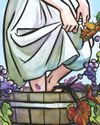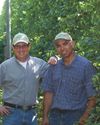Throughout brewing history, fermented beverages have used native ingredients. Plentiful and readily available, honey, dates, corn, as well as various herbs and spices often appeared in the recipes of historic or ancient beers. In much of Northern Europe, grog, Gruit, mead, and Braggot were commonplace before the German Reinheitsgebot, or purity law, of 1516 was instituted specifying that beer should contain nothing more than barley, yeast, hops, and water.

Once European settlers began arriving in North America, they lost ready access to malted barley and hops. Not ones to do without fermented beverages, these resourceful colonists substituted fruits and vegetables and other local ingredients, like spruce tips, to make their beer.
By the 1800s, standard brewing ingredients were widely available in the United States, yet some parts of the country still lacked key raw materials. Sometimes necessity truly is the mother of invention. Enter the Ptelea Trifoliata, also known as the hop tree or wafer ash, a shrub or small tree found throughout the Eastern half of the US and Canada.
This perennial has four to five stems and a thin, small, greenish yellow wing-like fruit, which provides bittering characteristics in a beer. Historically, wafer ash had medicinal and homeopathic uses, though it was never formally made into a drug. The wafer ash’s antiperiodic and stomachic properties were used to help treat diseases such as dyspepsia and debility. Tonic made from the plant was able to soothe mucous membranes, promoting appetite in sick patients.
Bu hikaye BeerAdvocate magazine dergisinin #127 (August 2017) sayısından alınmıştır.
Start your 7-day Magzter GOLD free trial to access thousands of curated premium stories, and 9,000+ magazines and newspapers.
Already a subscriber ? Giriş Yap
Bu hikaye BeerAdvocate magazine dergisinin #127 (August 2017) sayısından alınmıştır.
Start your 7-day Magzter GOLD free trial to access thousands of curated premium stories, and 9,000+ magazines and newspapers.
Already a subscriber? Giriş Yap

Trainers Incorporate Beer-Making Equipment Into Brewery-Hosted Workouts
On a typical Saturday morning, Johnathan Wakefield can be found hoisting kegs out front of his brewery, J. Wakefield Brewing Co., in Miami’s Wynwood neighborhood.
Mug Club 2.0
Craft Brewers Modify Loyalty Programs to Sow Deeper Relationships

Fruit Of The Vine
Now that fall’s here, it’s harvest time for a great many things. To zymurgical enthusiasts, that means grape season.

The Shaved Duck
Tucked away in an attractive brick neighborhood, just east of the second largest urban park in St. Louis, sits The Shaved Duck, one of the finest beer and barbecue joints west of the Mississippi.

John Segal Jr. The Hops Farmer
Although John Segal Jr. spent many childhood summers in Washington’s Yakima Valley and once brought a block of hops to show-and-tell, the third generation hops farmer never envisioned taking over the family business.

9 steps to beerdom
when david morgan first got into the craft business, it was as a retailer, and beer evangelism was a heavy lift. now, more than 15 years later, morgan is at the production end of the business, and the wind is at his back. singlespeed brewing, the cedar falls, iowa, nanobrewery morgan founded in 2012, is on the brink of a major expansion, as singlespeed exits its nano-sized beta version for a state of-the-art brewhouse opening late this year.

beau's all natural brewing company
after 32 years of working in the leather finishing industry, 55-year-old entrepreneur tim beauchesne was ready to make a bold career change.

higher prices, brighter futures?
the changing landscape of beer retail.

beer culture
as fresh hop beers multiply, so does experimentation

Birreria Volo
When your father is one of Canada’s most renowned craft beer publicans, opening your own beer bar is a high-pressure situation.